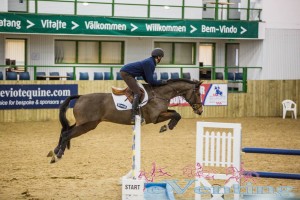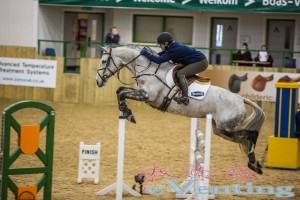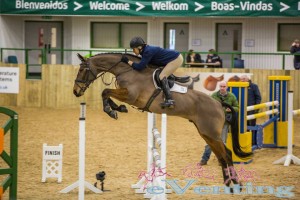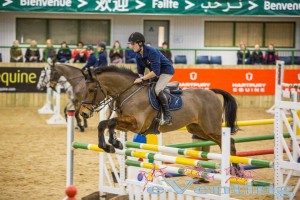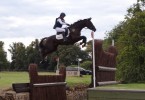The afternoon session was dedicated to Tom Holden discussing the showjumping course he had set up which we were able to walk and John Ledingham who was taking the riders through the course and improving performance.
The Course Builder – Tom Holden
The questions are the same as they have always been but what has changed is the intensity at which they are asked as riders have all got better.
You do not change the stride length until about 1.20m. In eventing there are not serious questions about lengthening or shortening the stride until 3* level.
It is legitimate to ask novice horses to ride curving lines. But they are nicer questions as it will be 2 strides straight, 2 strides curved then 2 strides straight. Less than 4 strides and this question should not be asked to novice horses. There should be an opportunity for the horse to land and then sort out its balance.
Related Distances – In a course you are likely to vary it. Left/right rein, oxer in, vertical in. You include as many legitimate questions as possible to reflect correct training.
Rollbacks – it is difficult to keep the horses balance at 1.10m level. So they are not really asked till higher levels. Liverpools mainly come in at 3* level but the horse should be familiar with them before that.
Alternatives – Not often a chance to use them very often but it makes it interesting for spectators.
As a course builder, Tom Holden does not like going too shallow with cups or too light with poles. Though he feels lighter poles do help the longevity of horses because they do not have the crashing through the back poles like in the past.
Water Trays – At novice level the water tray will be pulled out in front and at the higher levels it will be pushed back. At the higher levels having it pushed back will encourage the riders deeper. As a course builder Tom Holden rarely puts them under triple bars as there is too much stuff in the way. Water trays are a test of bravery and rideability.
Water Jumps – horses should be able to jump a water jump. If we close down the choice of fences it will all become boring.
Warm Ups – Showjumping Ireland is limiting the number of people in the warm ups to prevent accidents. Riders are now only allowed two people to help them. Safety barriers are put in the middle to help protect arena helpers. The zone between practice fences should be a horse free zone.
Two fences are plenty unless you have the space in the warm up. If you have space the other fence should be a cross pole. Practice arenas need space.
One of the things which has worked well is lunging areas – especially for 4yos at the beginning of the season.
The course Tom had built for riders was 1.20m-1.25m. He had used 20mm deep cups. The shallowest allowed are 18mm . In eventing you will often see 25mm cups. Tom explained that he felt 30mm cups were too deep.
Finally course builders watch how their courses ride and are always available for a chat if you have any questions.
John Ledingham
John had 4 riders – Jonelle Price on her grey mare Faerie Dianimo who was placed at Blenheim 3*, Tim Price on Wesko who won Blair 3*, Sarah Bullimore on Reve du Rouet who had competed at 3* and placed at Tattersalls 3* and Tom McEwen who was on a 6yo.
The first exercise set up was planks on the floor which could be ridden on 5 or 6 strides (set at 66ft).
John told the riders that accuracy was important. You have to give space on the planks for the hind legs to come through. Onus is on the rider to be accurate and the horse must be balanced and supple. We were told that this was a good exercise for control and balance.
Riders were asked to come on 6 strides, then 5 strides and the final question was to come on 5 strides and then 6 to the final plank on the ground. Straightness and a soft neck was emphasised. With the initial 6 strides riders were asked to then circle in canter and leg yeild in trot.
John Ledingham has a preference for warming up over an oxer first. His belief is that a vertical does not encourage the shoulders up and the bascule needed. The oxer should be square.
Tim Price was asked how many fences he would warm up over and he said normally 4/5/6 depending on the horse at a one day event. At a three day it was slightly different as horse might need to be made sharper or saved depending on how they came out. John Ledingham agreed saying not to overjump the horse before going into the ring.
As Tim and Jonelle jumped the warm up fences they were told to keep the horses neck up and soft. Jonelle was asked to keep straighter.
When you jump the oxer as a first fence you need to make sure that the horse is in front of the leg. The horse should be forward, straight and light. From Sarah, John wanted more commitment in the canter to jump the oxer. It was emphasised that she needed a little more leg to bring the horse off the floor but it should still be a soft leg.
Horses must learn to carry more canter, it does not just happen.
With Sarah’s horse warming up they pulled the ground line of the vertical out to help the horse maintain the bascule over it.
John asserted an emphasis on the importance of the leg being the 5th neck and it must be soft and not fighting against the rider.
Every fence should be ridden the same and should be perfect.
Develop a canter and a partnership so that they trust you.
You can generate scope from the canter. The better the canter, the better the horse will jump.
When jumping planks you should be insistent that the horse is soft.
If you have been standing around even in the collecting ring waiting to go in again make sure you get the horse moving again. Horses store red blood cells in their spleen for instant energy so if you get held up or you are waiting around you need to get into a good canter to the red blood cells can be released.
Tim Price’s second round
Analysis of the round
Jonelle’s round
Jonelle’s analysis
Sarah Bullimore’s round
Tom McEwen’s round (apologies for it going a bit funny – Ipad issues!!)
Liam Moggan chatted with the riders to understand their thought process and to ask them to recall their rounds in detail. This was to focus them on what they needed to be doing.
Liam also emphasised that you should not get caught up in negativity by asking yourself what would you change but this should be proceeded by what did you do well and what will you carry on doing?
Eric Smiley said that he now asks riders to tell him two things they like about their horse and one thing which they want to improve.
Overall the event was incredibly interesting. It does us no harm as riders to have the simplicity of training and key basics like straightness, being off the leg and the softness of the neck highlighted by such distinguished trainers. I think we often get caught up in the detail of training our horses and forget about the big key messages that are always needed in all three phases.
The one thing I would like to have seen is some riders with horses who are weaker in the showjumping phase as I think it would have been very interesting to see what improvements someone like John Ledingham could have wrought. I also think it is very common for amateur riders to become hugely flustered in the warm up and we do not often spend enough time having a system in place within the warm up so it would have been interesting to see this aspect highlighted some more with suggestions on how to deal with horses who were keen/backwards/spooky etc.
The International Eventing Forum will be back next year with Andrew Nicholson agreeing to come and do a slot, so keep 2nd February 2015 free!

